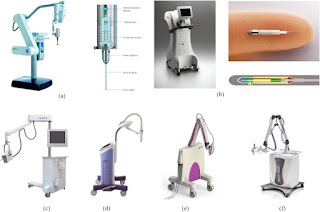advantages of brachytherapy and it's success rate
Brachytherapy (Internal Radiation Therapy) for Cervical Cancer
Cervical cancer is the
Radiation therapy is a potential treatment option for cervical cancer. This can either be given externally or internally. When radiation therapy is given internally it’s called brachytherapy.
Below, we’ll explore more about brachytherapy and what to expect when it’s used to treat cervical cancer.
Brachytherapy is one of the two types of radiation therapy that’s used to treat cervical cancer. It’s typically used along with external beam radiation therapy. It’s rarely used by itself.
In brachytherapy, an implant is placed into the body, near the area of the cancer. For cervical cancer, this may be in the vagina, cervix, or uterus. This type of brachytherapy is called intracavity brachytherapy.
Once the implant is in place, radioactive material is carefully placed inside of it. This radiation source acts to either kill cancer cells or prevent them from growing and dividing.
Brachytherapy takes advantage of something called the inverse square law, in which the dose of radiation rapidly declines as the distance from its source increases. Due to this, brachytherapy can provide a high dose of radiation to a nearby tumor while sparing other tissues or organs from damage.
External beam radiation therapy (EBRT) uses a machine to deliver radiation to the area where a tumor is located. It’s called an external therapy because the source of the radiation is outside of your body.
Receiving EBRT is painless and the treatment typically lasts a few minutes. Individuals receiving EBRT often do so over several outpatient visits. The exact number of visits will depend on your specific treatment plan.
EBRT is often combined with other cervical cancer treatments, such as chemotherapy. As mentioned above, it can also be used in combination with brachytherapy.
It’s possible that EBRT may be the primary treatment option in some people with cervical cancer. Some examples include those that cannot tolerate chemotherapy and individuals who can’t have surgery or opt not to have surgery.
Now let’s answer some common questions about what the brachytherapy procedure is like.
How are implants placed?
Implants for brachytherapy can also be referred to as applicators. The type of applicator and where it’s placed can vary based off of your pelvic anatomy.
If you have a uterus, there are a couple options for implant placement. Which one is used can depend on the type of brachytherapy that’s planned.
- Tandem and ovoid. A thin metal tube called a tandem is placed into the uterus. Round metal pieces called ovoids are placed along the side of the cervix to hold the tandem in place.
- Tandem and ring. A tandem is placed into the uterus. A disc-shaped holder is placed against the cervix to hold the tandem in place.
If your uterus has been removed as a result of a hysterectomy, an implant consisting of a thin metal tube can be positioned in your vagina.
Is implant placement painful?
Implants are typically placed when you’re under general anesthesia. That means that you’ll be asleep for the procedure and won’t feel anything.
When you wake up after implant placement, you may feel discomfort or pressure in your pelvic area. You’ll be given a pain medication to help ease these symptoms, particularly if you’ll be staying in the hospital for your treatment.
What’s treatment like?
After your implant has been placed, you’ll receive your treatment. During this time, you’ll be taken to a special room where radioactive material will be placed into the implant.
Hospital staff will take precautions to limit their exposure to radiation while you’re receiving treatment. If you’re staying in the hospital for your treatment, you may be asked to limit visitors while the radioactive material is in place.
How long will the implant be in place?
There are three types of brachytherapy:
- low-dose rate (LDR)
- high-dose rate (HDR)
- pulse-dose rate (PDR)
How long your implant stays in depends on which type of brachytherapy is used and what your doctor determines is appropriate for your treatment plan. It’s also important to note that treatments can vary from institution to institution for each type of brachytherapy.
Low-dose rate (LDR)
In LDR brachytherapy, you’ll have the implant with the radiation source in place for anywhere between 1 to 7 days. With LDR, the implant will deliver continuous radiation. You’ll stay in the hospital and be cared for by hospital staff. The implant will be removed after this time. The procedure to put in and to remove the implant is done in an operating room under anesthesia.
High-dose rate (HDR)
HDR brachytherapy is often an outpatient treatment. This means that you go home between treatments. The radiation source is only placed in the implant for 10 to 20 minutes at a time (or whatever amount of time your doctor determines is appropriate). Whether or not the implant itself stays in place between treatments will depend on your specific treatment plan.
Pulse-dose rate (PDR)
PDR brachytherapy is a hybrid of both HDR and LDR forms of brachytherapy. The procedure uses a similar level of radiation as HDR, but with the duration of LDR. The implant delivers a series of short exposures or “pulses,” approximately 10 to 30 minutes per hour (rather than continuously) for the treatment duration. Similar to LDR, the implant will remain inside for the duration of the treatment plan.
Radiation concerns
The radiation from the implant cannot travel very far in the body. Because of this, most of the side effects that you’ll experience will be in the area of the pelvis, specifically the cervix and vagina.
Additionally, once the radiation source is removed there won’t be any more radioactivity in your body. It will be safe for you to be around your family and friends.
Brachytherapy can help to improve outlook for cervical cancer. Let’s take a look at what some of the research says.
A
- Tumor remission: 92.5 percent of the people receiving EBRT plus brachytherapy achieved tumor remission, compared to 73.3 percent of people receiving EBRT alone.
- 5-year survival rate: The 5-year survival rate of the people receiving EBRT plus brachytherapy was 68.5 percent, compared to 35.4 percent for people receiving EBRT alone.
- Cancer recurrence: Cancer recurred in 31.3 percent of people getting EBRT plus brachytherapy, compared to 37.2 percent of people getting EBRT alone.
A
The short-term side effects of brachytherapy for cervical cancer are typically localized to the pelvic area. They can include:
- irritation of the vagina or vulva
- vaginal discharge
- abdominal discomfort
It’s also possible to experience some of the more general side effects associated with radiation therapy. Because you may receive brachytherapy after receiving EBRT, it may be difficult to tell which treatment is causing these side effects:
Coping with the short-term side effects of brachytherapy
The side effects from brachytherapy are typically temporary and will fade in the weeks after your treatment. A few tips for managing them include:
- Ask about medications. Side effects like discomfort, nausea, and diarrhea can all be managed using medications. If you’re interested in medications for these side effects, be sure to talk to your care team.
- Rest up. It you’re experiencing fatigue, take time to get enough rest. Try to get at least 8 hours of sleep each night and to not overexert yourself.
- Drink plenty of water. Making sure to drink enough water can help prevent dehydration due to vomiting or diarrhea. Drinking water can also help to ease bladder irritation.
- Consider food. If you’re experiencing nausea, vomiting, or diarrhea, avoid foods that might irritate your digestive tract.
- Be kind to your skin. If you have irritation in the vagina or vulva, avoid personal care products that may further irritate the area, such as certain soaps or bubble baths. Wearing loose, breathable undergarments may also help.
Radiation therapies like brachytherapy can also carry the risk of long-term side effects or complications. These may appear in the months to years after treatment and can include:
- Vaginal stenosis. Vaginal stenosis is a condition where scar tissue makes the vagina narrower and reduces its ability to stretch. This can make sex difficult or painful.
- Vaginal dryness. Radiation may lead to changes in the lining of the vagina, making it drier. This can make sex painful.
- Rectal stenosis. Rectal stenosis is a narrowing of the rectum, which can make having bowel movements difficult or painful.
- Radiation cystitis. Radiation can lead to chronic irritation of the bladder. This can cause symptoms like frequent urination, pelvic pain, and blood in the urine.
- Lymphedema. Lymphedema is a condition where lymph fluid cannot drain properly from the leg, leading to swelling.
If you think that you may be experiencing any complications from brachytherapy, be sure to see your doctor. They can work with you to develop a plan to help manage symptoms.
Brachytherapy is a type of radiation therapy for cervical cancer. It involves placing a radioactive material within an implant that’s been placed close to a tumor.
The radiation from brachytherapy can only travel a short distance from its source. Additionally, after the radiation source as been removed from the implant, it’s safe to be around family and friends.
The amount of time that an implant is in place depends on the type of brachytherapy you’re receiving as well as your individual treatment plan. Your doctor will let you know what exactly you can expect.
The side effects of brachytherapy are often temporary and can be managed with medications and lifestyle changes. Long-term complications can happen in some people, so be sure to contact your doctor promptly if you believe you’re having complications from brachytherapy.
Last medically reviewed on June 28, 2021
How we reviewed this article:
Share this article
READ THIS NEXT
- How Do You Know If You Have Cervical Cancer?Medically reviewed by Deborah Weatherspoon, Ph.D., MSN
READ MORE
#gazicancercarecenter#brachytherapy#iort#hitechtreatment#availability#economictreatment#gazimedicalcollegehospital#mohakhali#dhaka


















Comments